BUGEN 5930 - Reflective Journal: Sustainable Business Analysis
VerifiedAdded on 2023/06/09
|9
|1871
|277
Journal and Reflective Writing
AI Summary
This reflective journal explores the concept of sustainable business, emphasizing the need for organizations to manage environmental, financial, and social risks. It discusses the triple bottom line (social, financial, and environmental aspects) as a framework for evaluating business performance. The journal covers various aspects of business sustainability, including the six forms of capital (financial, manufactured, intellectual, human, natural, and social), and the six phases of business approaches to sustainability (stakeholder engagement, environmental focus, life cycle analysis, reporting and disclosure, leadership development, and embedding sustainability across key functional areas). The author provides personal reflections on the relevance and implications of these themes for the business sector, highlighting the importance of sustainability in attracting and retaining employees, and reducing financial risks. The journal emphasizes the need for leadership and the integration of sustainability across key functional areas for overall business success.
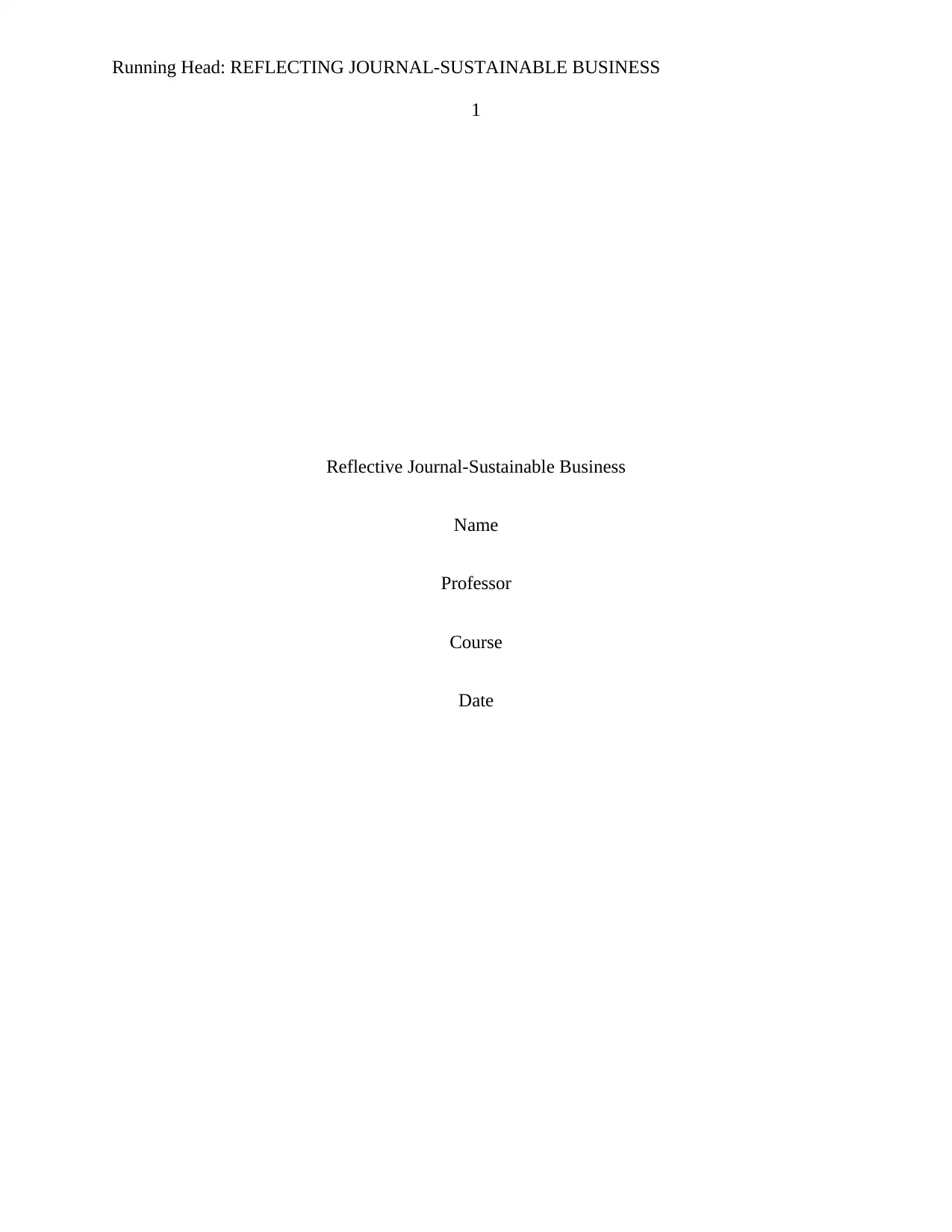
Running Head: REFLECTING JOURNAL-SUSTAINABLE BUSINESS
1
Reflective Journal-Sustainable Business
Name
Professor
Course
Date
1
Reflective Journal-Sustainable Business
Name
Professor
Course
Date
Paraphrase This Document
Need a fresh take? Get an instant paraphrase of this document with our AI Paraphraser
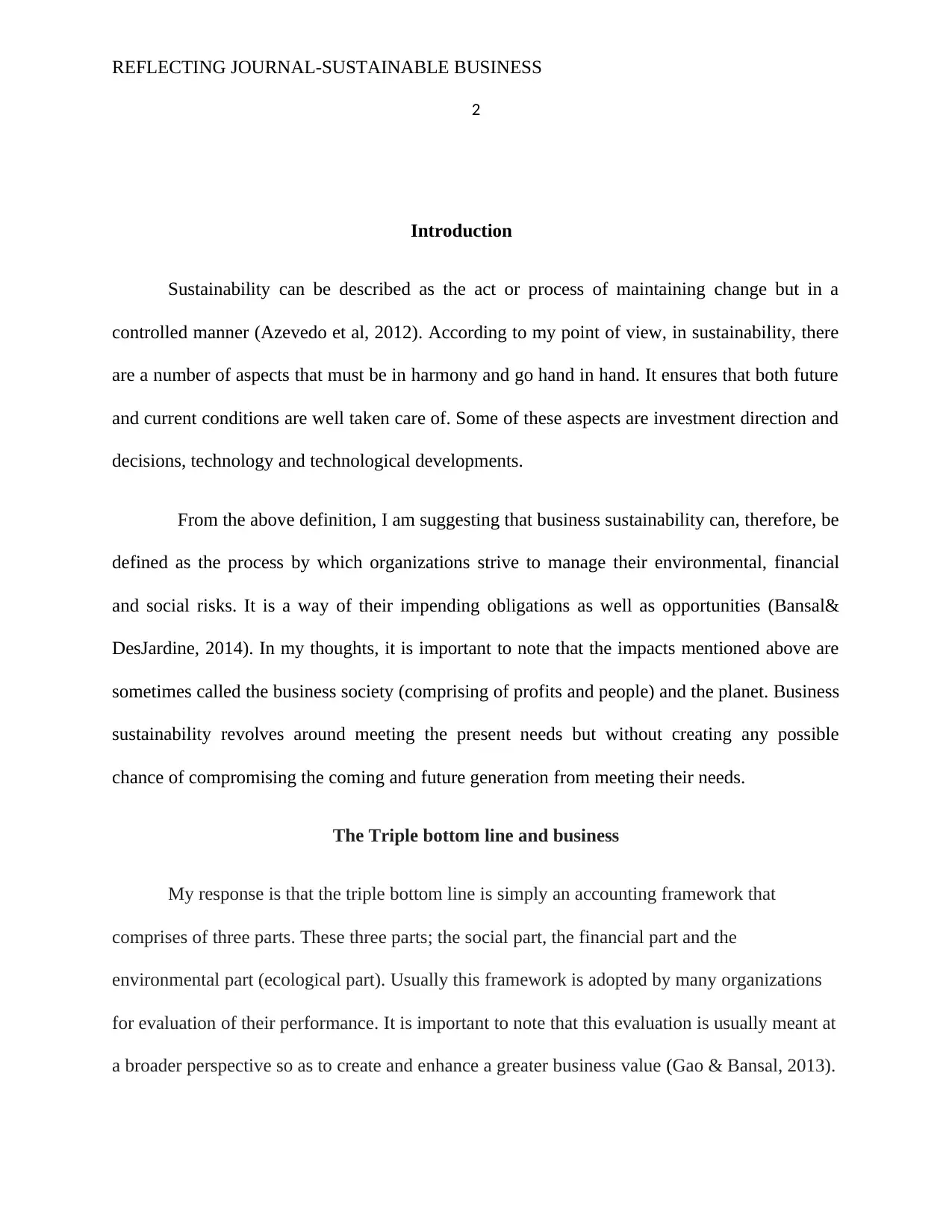
REFLECTING JOURNAL-SUSTAINABLE BUSINESS
2
Introduction
Sustainability can be described as the act or process of maintaining change but in a
controlled manner (Azevedo et al, 2012). According to my point of view, in sustainability, there
are a number of aspects that must be in harmony and go hand in hand. It ensures that both future
and current conditions are well taken care of. Some of these aspects are investment direction and
decisions, technology and technological developments.
From the above definition, I am suggesting that business sustainability can, therefore, be
defined as the process by which organizations strive to manage their environmental, financial
and social risks. It is a way of their impending obligations as well as opportunities (Bansal&
DesJardine, 2014). In my thoughts, it is important to note that the impacts mentioned above are
sometimes called the business society (comprising of profits and people) and the planet. Business
sustainability revolves around meeting the present needs but without creating any possible
chance of compromising the coming and future generation from meeting their needs.
The Triple bottom line and business
My response is that the triple bottom line is simply an accounting framework that
comprises of three parts. These three parts; the social part, the financial part and the
environmental part (ecological part). Usually this framework is adopted by many organizations
for evaluation of their performance. It is important to note that this evaluation is usually meant at
a broader perspective so as to create and enhance a greater business value (Gao & Bansal, 2013).
2
Introduction
Sustainability can be described as the act or process of maintaining change but in a
controlled manner (Azevedo et al, 2012). According to my point of view, in sustainability, there
are a number of aspects that must be in harmony and go hand in hand. It ensures that both future
and current conditions are well taken care of. Some of these aspects are investment direction and
decisions, technology and technological developments.
From the above definition, I am suggesting that business sustainability can, therefore, be
defined as the process by which organizations strive to manage their environmental, financial
and social risks. It is a way of their impending obligations as well as opportunities (Bansal&
DesJardine, 2014). In my thoughts, it is important to note that the impacts mentioned above are
sometimes called the business society (comprising of profits and people) and the planet. Business
sustainability revolves around meeting the present needs but without creating any possible
chance of compromising the coming and future generation from meeting their needs.
The Triple bottom line and business
My response is that the triple bottom line is simply an accounting framework that
comprises of three parts. These three parts; the social part, the financial part and the
environmental part (ecological part). Usually this framework is adopted by many organizations
for evaluation of their performance. It is important to note that this evaluation is usually meant at
a broader perspective so as to create and enhance a greater business value (Gao & Bansal, 2013).
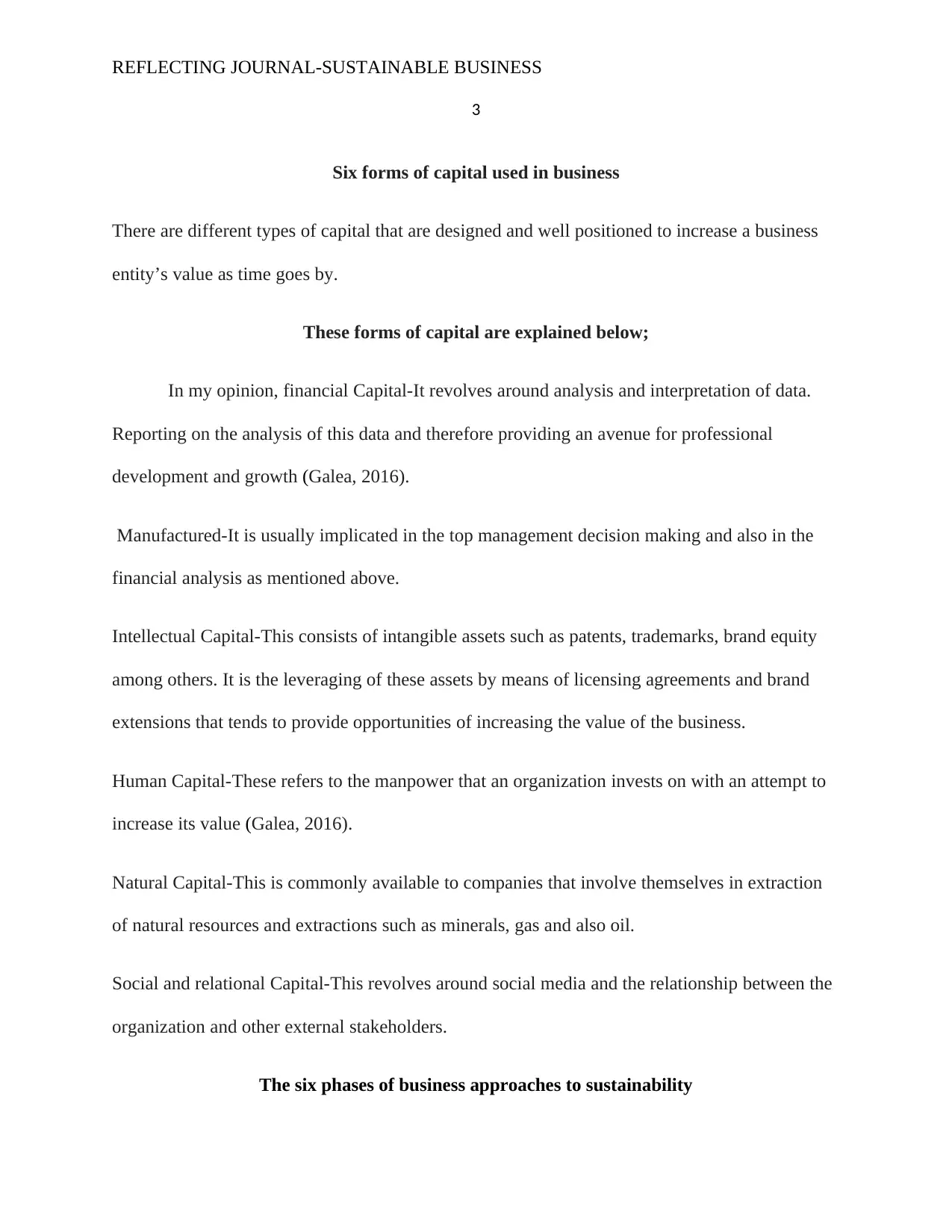
REFLECTING JOURNAL-SUSTAINABLE BUSINESS
3
Six forms of capital used in business
There are different types of capital that are designed and well positioned to increase a business
entity’s value as time goes by.
These forms of capital are explained below;
In my opinion, financial Capital-It revolves around analysis and interpretation of data.
Reporting on the analysis of this data and therefore providing an avenue for professional
development and growth (Galea, 2016).
Manufactured-It is usually implicated in the top management decision making and also in the
financial analysis as mentioned above.
Intellectual Capital-This consists of intangible assets such as patents, trademarks, brand equity
among others. It is the leveraging of these assets by means of licensing agreements and brand
extensions that tends to provide opportunities of increasing the value of the business.
Human Capital-These refers to the manpower that an organization invests on with an attempt to
increase its value (Galea, 2016).
Natural Capital-This is commonly available to companies that involve themselves in extraction
of natural resources and extractions such as minerals, gas and also oil.
Social and relational Capital-This revolves around social media and the relationship between the
organization and other external stakeholders.
The six phases of business approaches to sustainability
3
Six forms of capital used in business
There are different types of capital that are designed and well positioned to increase a business
entity’s value as time goes by.
These forms of capital are explained below;
In my opinion, financial Capital-It revolves around analysis and interpretation of data.
Reporting on the analysis of this data and therefore providing an avenue for professional
development and growth (Galea, 2016).
Manufactured-It is usually implicated in the top management decision making and also in the
financial analysis as mentioned above.
Intellectual Capital-This consists of intangible assets such as patents, trademarks, brand equity
among others. It is the leveraging of these assets by means of licensing agreements and brand
extensions that tends to provide opportunities of increasing the value of the business.
Human Capital-These refers to the manpower that an organization invests on with an attempt to
increase its value (Galea, 2016).
Natural Capital-This is commonly available to companies that involve themselves in extraction
of natural resources and extractions such as minerals, gas and also oil.
Social and relational Capital-This revolves around social media and the relationship between the
organization and other external stakeholders.
The six phases of business approaches to sustainability
⊘ This is a preview!⊘
Do you want full access?
Subscribe today to unlock all pages.

Trusted by 1+ million students worldwide
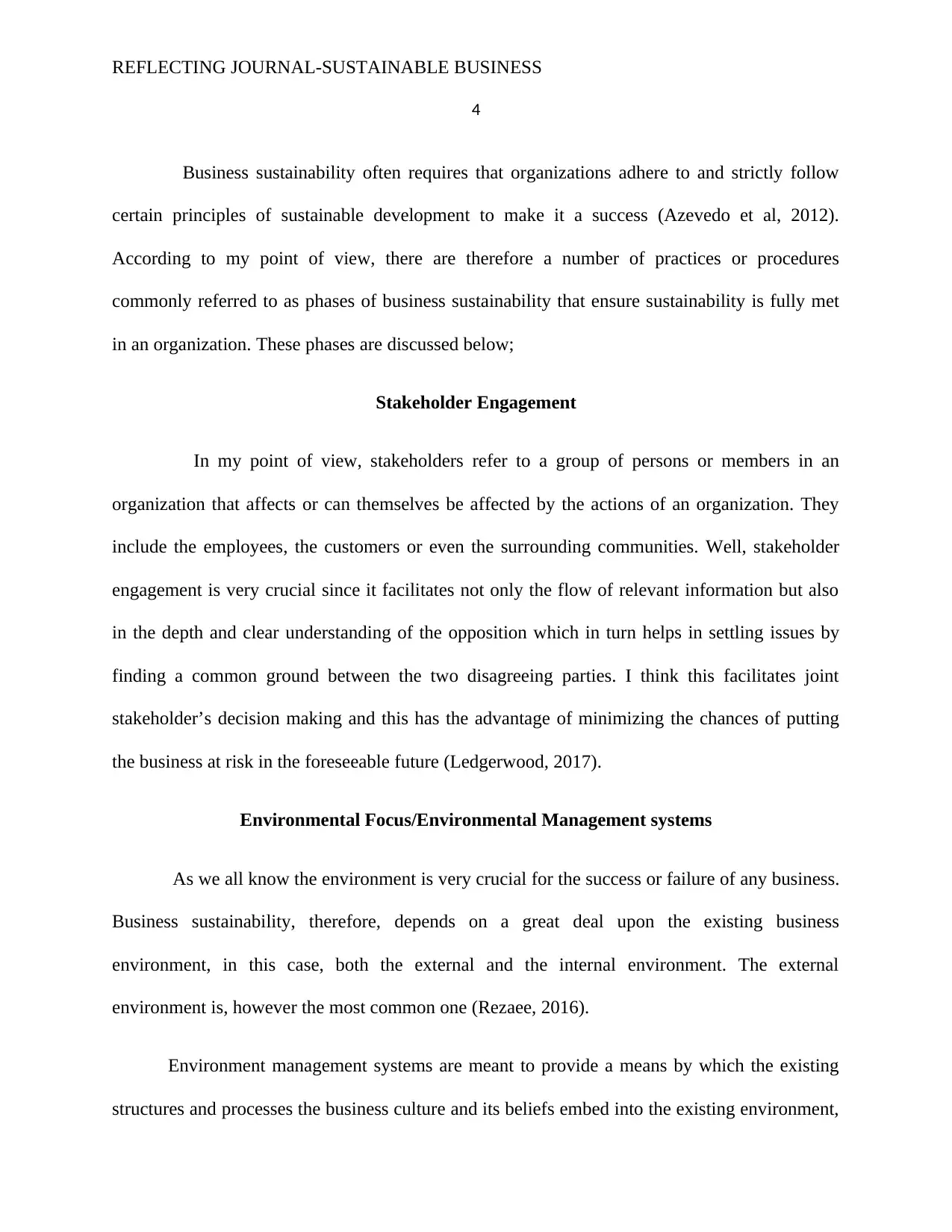
REFLECTING JOURNAL-SUSTAINABLE BUSINESS
4
Business sustainability often requires that organizations adhere to and strictly follow
certain principles of sustainable development to make it a success (Azevedo et al, 2012).
According to my point of view, there are therefore a number of practices or procedures
commonly referred to as phases of business sustainability that ensure sustainability is fully met
in an organization. These phases are discussed below;
Stakeholder Engagement
In my point of view, stakeholders refer to a group of persons or members in an
organization that affects or can themselves be affected by the actions of an organization. They
include the employees, the customers or even the surrounding communities. Well, stakeholder
engagement is very crucial since it facilitates not only the flow of relevant information but also
in the depth and clear understanding of the opposition which in turn helps in settling issues by
finding a common ground between the two disagreeing parties. I think this facilitates joint
stakeholder’s decision making and this has the advantage of minimizing the chances of putting
the business at risk in the foreseeable future (Ledgerwood, 2017).
Environmental Focus/Environmental Management systems
As we all know the environment is very crucial for the success or failure of any business.
Business sustainability, therefore, depends on a great deal upon the existing business
environment, in this case, both the external and the internal environment. The external
environment is, however the most common one (Rezaee, 2016).
Environment management systems are meant to provide a means by which the existing
structures and processes the business culture and its beliefs embed into the existing environment,
4
Business sustainability often requires that organizations adhere to and strictly follow
certain principles of sustainable development to make it a success (Azevedo et al, 2012).
According to my point of view, there are therefore a number of practices or procedures
commonly referred to as phases of business sustainability that ensure sustainability is fully met
in an organization. These phases are discussed below;
Stakeholder Engagement
In my point of view, stakeholders refer to a group of persons or members in an
organization that affects or can themselves be affected by the actions of an organization. They
include the employees, the customers or even the surrounding communities. Well, stakeholder
engagement is very crucial since it facilitates not only the flow of relevant information but also
in the depth and clear understanding of the opposition which in turn helps in settling issues by
finding a common ground between the two disagreeing parties. I think this facilitates joint
stakeholder’s decision making and this has the advantage of minimizing the chances of putting
the business at risk in the foreseeable future (Ledgerwood, 2017).
Environmental Focus/Environmental Management systems
As we all know the environment is very crucial for the success or failure of any business.
Business sustainability, therefore, depends on a great deal upon the existing business
environment, in this case, both the external and the internal environment. The external
environment is, however the most common one (Rezaee, 2016).
Environment management systems are meant to provide a means by which the existing
structures and processes the business culture and its beliefs embed into the existing environment,
Paraphrase This Document
Need a fresh take? Get an instant paraphrase of this document with our AI Paraphraser
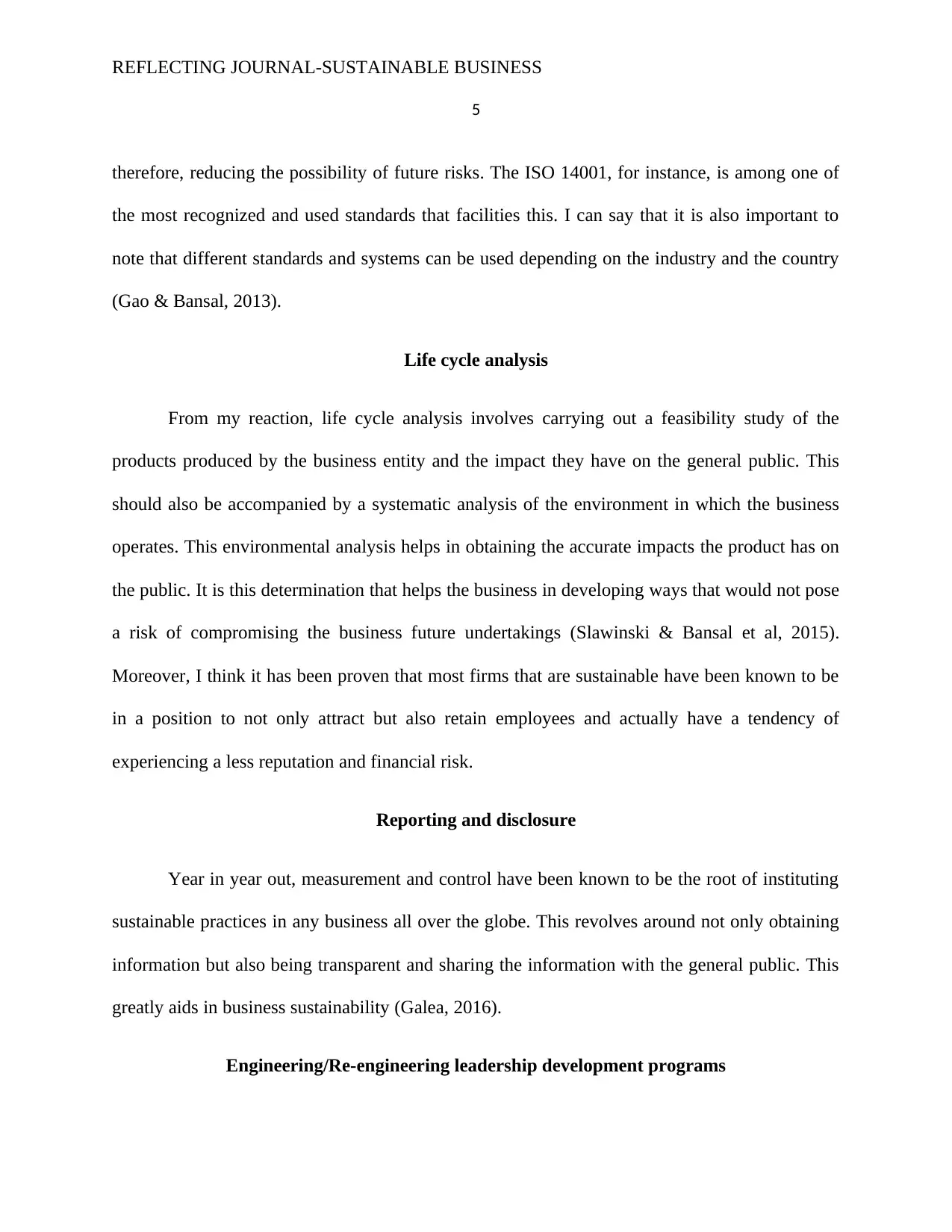
REFLECTING JOURNAL-SUSTAINABLE BUSINESS
5
therefore, reducing the possibility of future risks. The ISO 14001, for instance, is among one of
the most recognized and used standards that facilities this. I can say that it is also important to
note that different standards and systems can be used depending on the industry and the country
(Gao & Bansal, 2013).
Life cycle analysis
From my reaction, life cycle analysis involves carrying out a feasibility study of the
products produced by the business entity and the impact they have on the general public. This
should also be accompanied by a systematic analysis of the environment in which the business
operates. This environmental analysis helps in obtaining the accurate impacts the product has on
the public. It is this determination that helps the business in developing ways that would not pose
a risk of compromising the business future undertakings (Slawinski & Bansal et al, 2015).
Moreover, I think it has been proven that most firms that are sustainable have been known to be
in a position to not only attract but also retain employees and actually have a tendency of
experiencing a less reputation and financial risk.
Reporting and disclosure
Year in year out, measurement and control have been known to be the root of instituting
sustainable practices in any business all over the globe. This revolves around not only obtaining
information but also being transparent and sharing the information with the general public. This
greatly aids in business sustainability (Galea, 2016).
Engineering/Re-engineering leadership development programs
5
therefore, reducing the possibility of future risks. The ISO 14001, for instance, is among one of
the most recognized and used standards that facilities this. I can say that it is also important to
note that different standards and systems can be used depending on the industry and the country
(Gao & Bansal, 2013).
Life cycle analysis
From my reaction, life cycle analysis involves carrying out a feasibility study of the
products produced by the business entity and the impact they have on the general public. This
should also be accompanied by a systematic analysis of the environment in which the business
operates. This environmental analysis helps in obtaining the accurate impacts the product has on
the public. It is this determination that helps the business in developing ways that would not pose
a risk of compromising the business future undertakings (Slawinski & Bansal et al, 2015).
Moreover, I think it has been proven that most firms that are sustainable have been known to be
in a position to not only attract but also retain employees and actually have a tendency of
experiencing a less reputation and financial risk.
Reporting and disclosure
Year in year out, measurement and control have been known to be the root of instituting
sustainable practices in any business all over the globe. This revolves around not only obtaining
information but also being transparent and sharing the information with the general public. This
greatly aids in business sustainability (Galea, 2016).
Engineering/Re-engineering leadership development programs
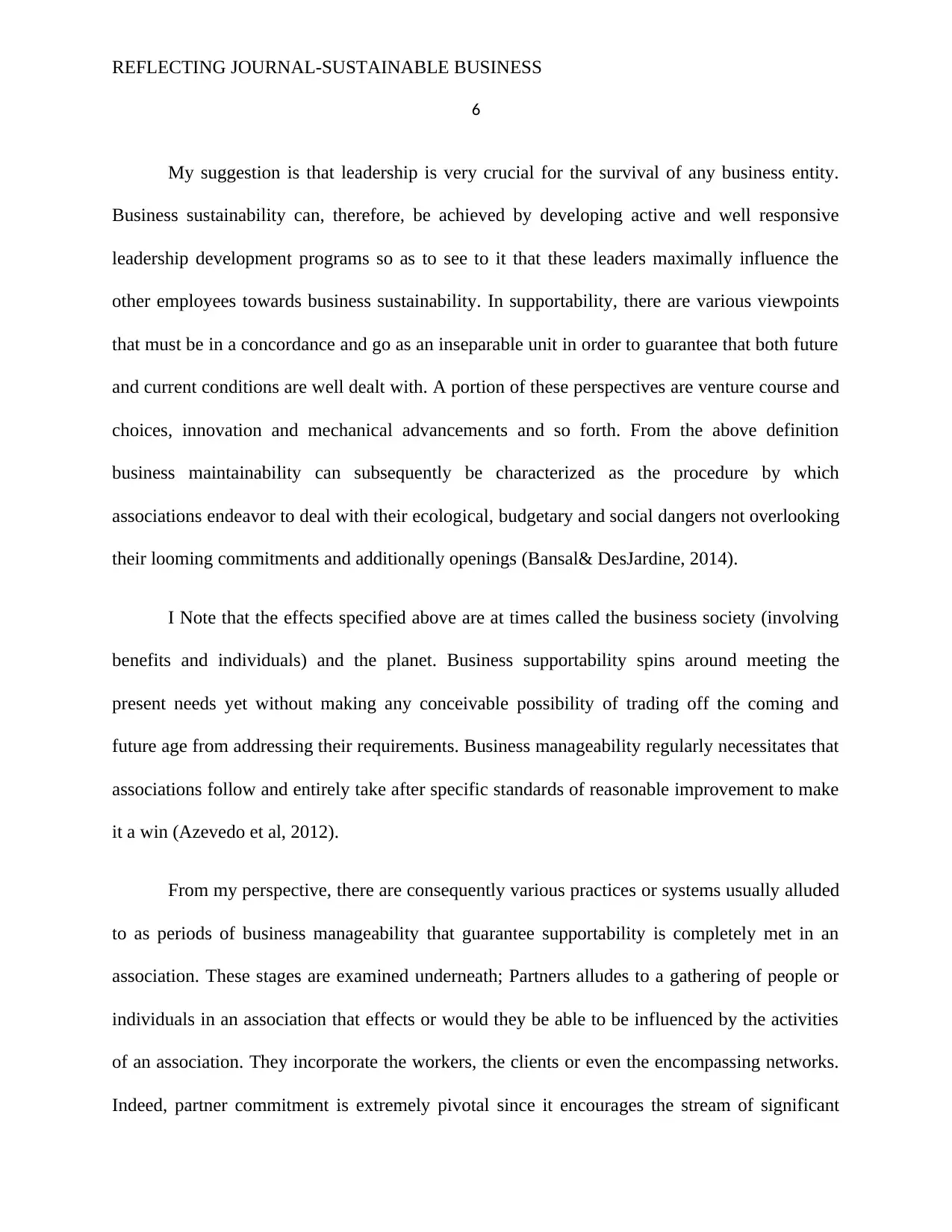
REFLECTING JOURNAL-SUSTAINABLE BUSINESS
6
My suggestion is that leadership is very crucial for the survival of any business entity.
Business sustainability can, therefore, be achieved by developing active and well responsive
leadership development programs so as to see to it that these leaders maximally influence the
other employees towards business sustainability. In supportability, there are various viewpoints
that must be in a concordance and go as an inseparable unit in order to guarantee that both future
and current conditions are well dealt with. A portion of these perspectives are venture course and
choices, innovation and mechanical advancements and so forth. From the above definition
business maintainability can subsequently be characterized as the procedure by which
associations endeavor to deal with their ecological, budgetary and social dangers not overlooking
their looming commitments and additionally openings (Bansal& DesJardine, 2014).
I Note that the effects specified above are at times called the business society (involving
benefits and individuals) and the planet. Business supportability spins around meeting the
present needs yet without making any conceivable possibility of trading off the coming and
future age from addressing their requirements. Business manageability regularly necessitates that
associations follow and entirely take after specific standards of reasonable improvement to make
it a win (Azevedo et al, 2012).
From my perspective, there are consequently various practices or systems usually alluded
to as periods of business manageability that guarantee supportability is completely met in an
association. These stages are examined underneath; Partners alludes to a gathering of people or
individuals in an association that effects or would they be able to be influenced by the activities
of an association. They incorporate the workers, the clients or even the encompassing networks.
Indeed, partner commitment is extremely pivotal since it encourages the stream of significant
6
My suggestion is that leadership is very crucial for the survival of any business entity.
Business sustainability can, therefore, be achieved by developing active and well responsive
leadership development programs so as to see to it that these leaders maximally influence the
other employees towards business sustainability. In supportability, there are various viewpoints
that must be in a concordance and go as an inseparable unit in order to guarantee that both future
and current conditions are well dealt with. A portion of these perspectives are venture course and
choices, innovation and mechanical advancements and so forth. From the above definition
business maintainability can subsequently be characterized as the procedure by which
associations endeavor to deal with their ecological, budgetary and social dangers not overlooking
their looming commitments and additionally openings (Bansal& DesJardine, 2014).
I Note that the effects specified above are at times called the business society (involving
benefits and individuals) and the planet. Business supportability spins around meeting the
present needs yet without making any conceivable possibility of trading off the coming and
future age from addressing their requirements. Business manageability regularly necessitates that
associations follow and entirely take after specific standards of reasonable improvement to make
it a win (Azevedo et al, 2012).
From my perspective, there are consequently various practices or systems usually alluded
to as periods of business manageability that guarantee supportability is completely met in an
association. These stages are examined underneath; Partners alludes to a gathering of people or
individuals in an association that effects or would they be able to be influenced by the activities
of an association. They incorporate the workers, the clients or even the encompassing networks.
Indeed, partner commitment is extremely pivotal since it encourages the stream of significant
⊘ This is a preview!⊘
Do you want full access?
Subscribe today to unlock all pages.

Trusted by 1+ million students worldwide
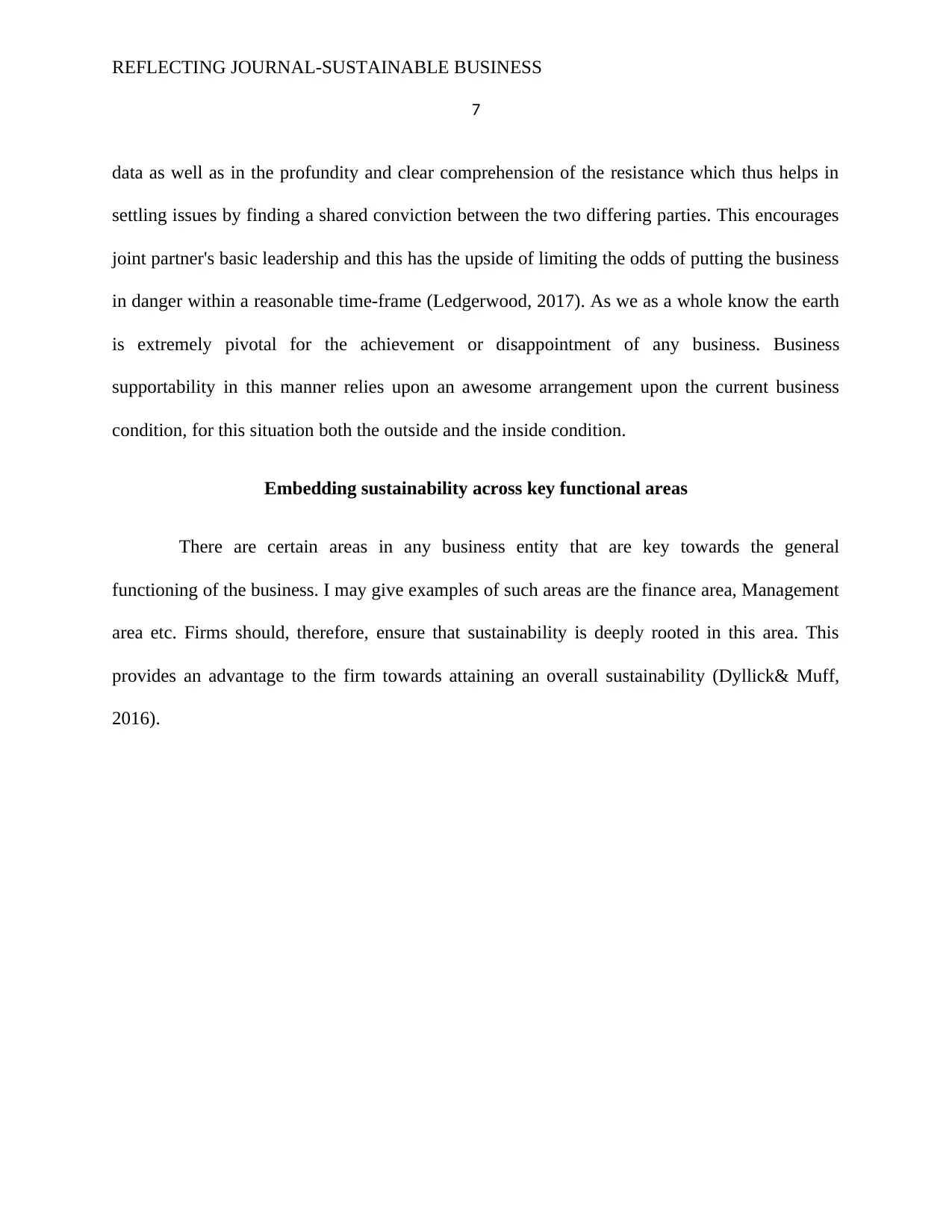
REFLECTING JOURNAL-SUSTAINABLE BUSINESS
7
data as well as in the profundity and clear comprehension of the resistance which thus helps in
settling issues by finding a shared conviction between the two differing parties. This encourages
joint partner's basic leadership and this has the upside of limiting the odds of putting the business
in danger within a reasonable time-frame (Ledgerwood, 2017). As we as a whole know the earth
is extremely pivotal for the achievement or disappointment of any business. Business
supportability in this manner relies upon an awesome arrangement upon the current business
condition, for this situation both the outside and the inside condition.
Embedding sustainability across key functional areas
There are certain areas in any business entity that are key towards the general
functioning of the business. I may give examples of such areas are the finance area, Management
area etc. Firms should, therefore, ensure that sustainability is deeply rooted in this area. This
provides an advantage to the firm towards attaining an overall sustainability (Dyllick& Muff,
2016).
7
data as well as in the profundity and clear comprehension of the resistance which thus helps in
settling issues by finding a shared conviction between the two differing parties. This encourages
joint partner's basic leadership and this has the upside of limiting the odds of putting the business
in danger within a reasonable time-frame (Ledgerwood, 2017). As we as a whole know the earth
is extremely pivotal for the achievement or disappointment of any business. Business
supportability in this manner relies upon an awesome arrangement upon the current business
condition, for this situation both the outside and the inside condition.
Embedding sustainability across key functional areas
There are certain areas in any business entity that are key towards the general
functioning of the business. I may give examples of such areas are the finance area, Management
area etc. Firms should, therefore, ensure that sustainability is deeply rooted in this area. This
provides an advantage to the firm towards attaining an overall sustainability (Dyllick& Muff,
2016).
Paraphrase This Document
Need a fresh take? Get an instant paraphrase of this document with our AI Paraphraser
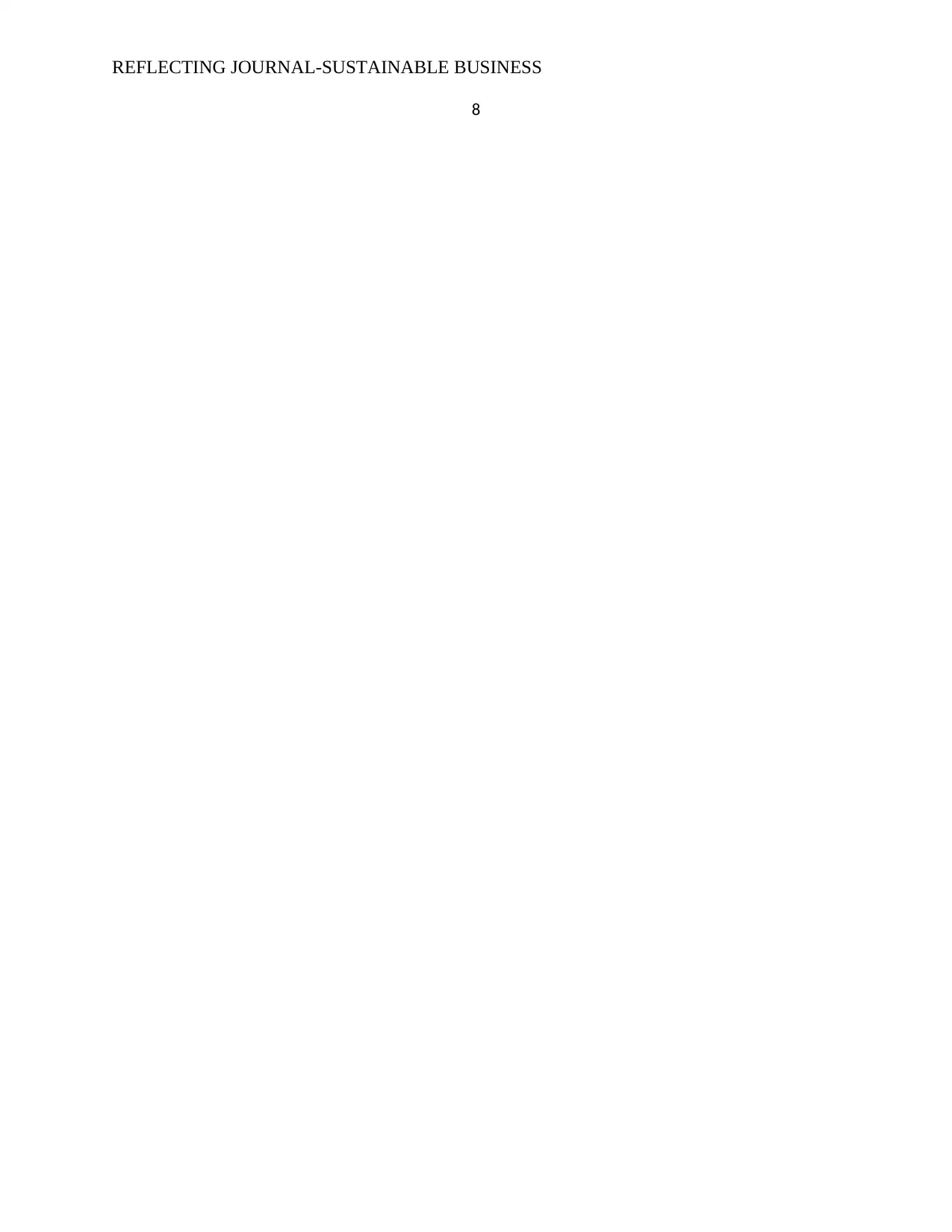
REFLECTING JOURNAL-SUSTAINABLE BUSINESS
8
8
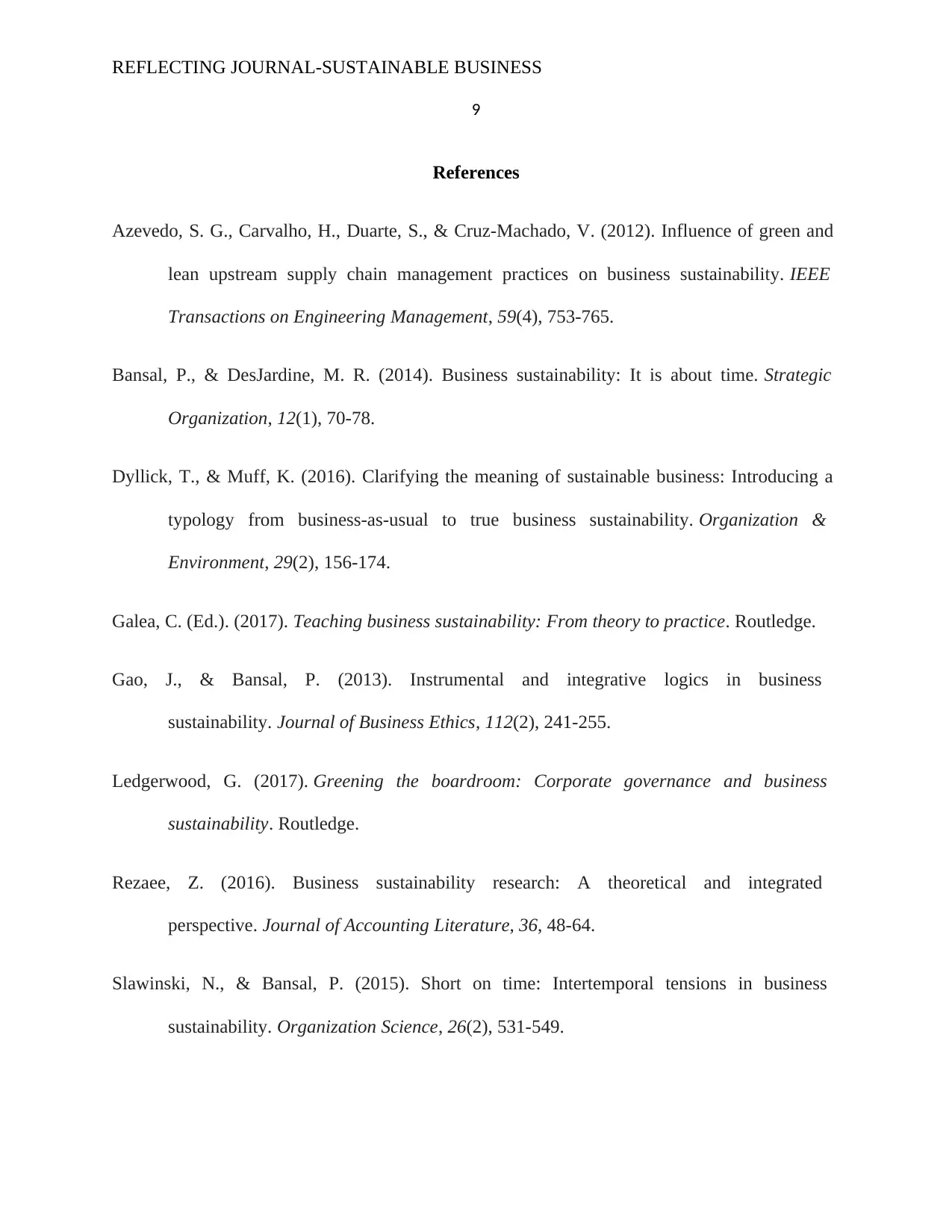
REFLECTING JOURNAL-SUSTAINABLE BUSINESS
9
References
Azevedo, S. G., Carvalho, H., Duarte, S., & Cruz-Machado, V. (2012). Influence of green and
lean upstream supply chain management practices on business sustainability. IEEE
Transactions on Engineering Management, 59(4), 753-765.
Bansal, P., & DesJardine, M. R. (2014). Business sustainability: It is about time. Strategic
Organization, 12(1), 70-78.
Dyllick, T., & Muff, K. (2016). Clarifying the meaning of sustainable business: Introducing a
typology from business-as-usual to true business sustainability. Organization &
Environment, 29(2), 156-174.
Galea, C. (Ed.). (2017). Teaching business sustainability: From theory to practice. Routledge.
Gao, J., & Bansal, P. (2013). Instrumental and integrative logics in business
sustainability. Journal of Business Ethics, 112(2), 241-255.
Ledgerwood, G. (2017). Greening the boardroom: Corporate governance and business
sustainability. Routledge.
Rezaee, Z. (2016). Business sustainability research: A theoretical and integrated
perspective. Journal of Accounting Literature, 36, 48-64.
Slawinski, N., & Bansal, P. (2015). Short on time: Intertemporal tensions in business
sustainability. Organization Science, 26(2), 531-549.
9
References
Azevedo, S. G., Carvalho, H., Duarte, S., & Cruz-Machado, V. (2012). Influence of green and
lean upstream supply chain management practices on business sustainability. IEEE
Transactions on Engineering Management, 59(4), 753-765.
Bansal, P., & DesJardine, M. R. (2014). Business sustainability: It is about time. Strategic
Organization, 12(1), 70-78.
Dyllick, T., & Muff, K. (2016). Clarifying the meaning of sustainable business: Introducing a
typology from business-as-usual to true business sustainability. Organization &
Environment, 29(2), 156-174.
Galea, C. (Ed.). (2017). Teaching business sustainability: From theory to practice. Routledge.
Gao, J., & Bansal, P. (2013). Instrumental and integrative logics in business
sustainability. Journal of Business Ethics, 112(2), 241-255.
Ledgerwood, G. (2017). Greening the boardroom: Corporate governance and business
sustainability. Routledge.
Rezaee, Z. (2016). Business sustainability research: A theoretical and integrated
perspective. Journal of Accounting Literature, 36, 48-64.
Slawinski, N., & Bansal, P. (2015). Short on time: Intertemporal tensions in business
sustainability. Organization Science, 26(2), 531-549.
⊘ This is a preview!⊘
Do you want full access?
Subscribe today to unlock all pages.

Trusted by 1+ million students worldwide
1 out of 9
Related Documents
Your All-in-One AI-Powered Toolkit for Academic Success.
+13062052269
info@desklib.com
Available 24*7 on WhatsApp / Email
![[object Object]](/_next/static/media/star-bottom.7253800d.svg)
Unlock your academic potential
Copyright © 2020–2025 A2Z Services. All Rights Reserved. Developed and managed by ZUCOL.



